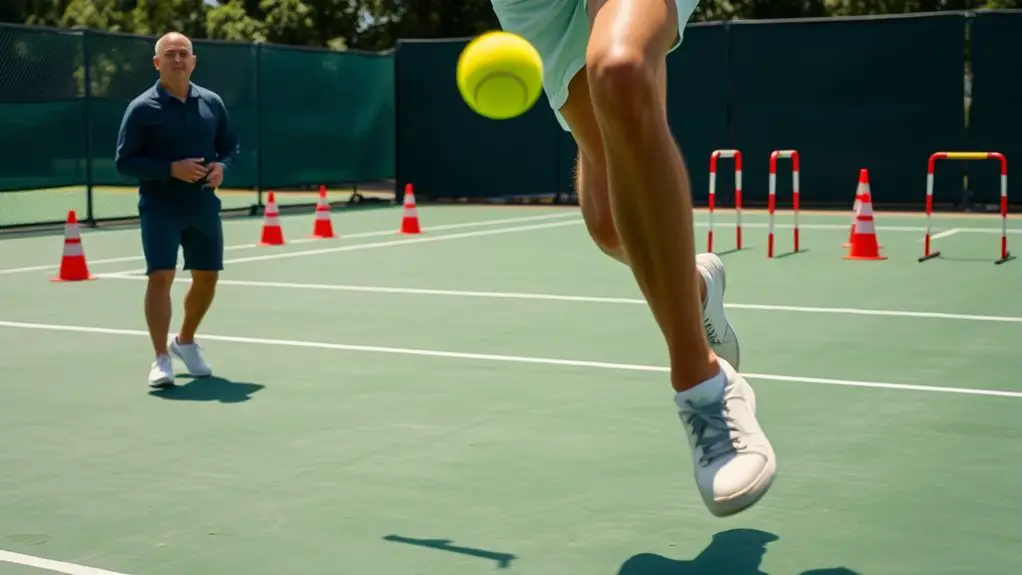To build speed and endurance for tennis, focus on a mix of conditioning exercises like plyometrics and sprint drills, along with interval training that mimics match intensity. Incorporate agility drills to improve court movement and work on steady-state cardio for stamina. Don't forget about nutrition; eat complex carbs for energy and lean proteins for recovery. Rest and active recovery are key to maintaining peak condition. Keep going to discover more effective strategies for your training.
Understanding the Importance of Speed and Endurance in Tennis
When you step onto the court, you quickly realize that speed and endurance are essential for your success in tennis. The game demands quick bursts of energy to chase down balls and respond to your opponent's shots. If you lack speed, you'll struggle to reach the net or cover the baseline effectively. Endurance is equally important; matches can last for hours, and maintaining your energy levels can make the difference between winning and losing.
With every match, you're not just playing; you're engaging in a test of stamina and agility. Building these attributes allows you the freedom to express your style and take risks, knowing you've got the physical capacity to back it up. So, embrace the challenge! Understanding the significance of speed and endurance will empower you, making every rally an opportunity for growth and mastery on the court. Additionally, incorporating strength training into your routine can significantly enhance your ability to maintain speed and endurance throughout a match.
Essential Physical Conditioning Exercises
To boost your speed and endurance for tennis, focusing on essential physical conditioning exercises is key. Incorporating plyometric training techniques and interval running workouts can greatly enhance your performance on the court. Let's explore how these exercises can make a difference in your game. Additionally, implementing sprinting drills will further develop your acceleration and overall speed, crucial for quick movements during matches.
Plyometric Training Techniques
Plyometric training techniques are essential for enhancing your speed and endurance on the tennis court, as they focus on explosive movements that build power and agility. Incorporate exercises like box jumps, burpees, and lateral bounds into your routine. These drills not only improve your quickness but also help develop the muscular strength needed for those high-intensity rallies. Start with lower heights or distances to avoid injury and gradually increase the challenge as you get stronger. Aim for a mix of explosive jumps and agile footwork to keep your workouts dynamic. Remember, the goal is to replicate the burst of energy you'll need during matches while enjoying the freedom of movement. Embrace the sweat, and you'll notice the difference in your game!
Interval Running Workouts
Interval running workouts are a fantastic way to boost your speed and endurance for tennis. By combining short bursts of intense effort with periods of rest or lower intensity, you'll mimic the demands of a match. Start with a simple routine: sprint for 30 seconds, then walk or jog for a minute. Repeat this for 15-20 minutes. As you get stronger, increase the sprint duration or decrease rest time. You'll not only build cardiovascular fitness but also improve your recovery time between points. The freedom of interval training lies in its flexibility—you can do it anywhere, anytime. So lace up those shoes and embrace the challenge; your game will transform, giving you the edge on the court.
Incorporating Interval Training Into Your Routine
Incorporating interval training into your routine can notably boost your speed and endurance on the court. You'll discover various workout routines that fit your schedule, and tracking your progress will help keep you motivated. Let's explore the benefits and practical ways to get started with interval training. Additionally, utilizing high-intensity interval training can efficiently improve your cardiovascular fitness and overall performance.
Benefits of Interval Training
While many training methods can improve your tennis performance, interval training stands out for its ability to boost both speed and endurance effectively. This type of training allows you to alternate between high-intensity bursts and periods of lower intensity or rest, mimicking the on-court demands of tennis. You'll find that it not only enhances your cardiovascular fitness but also increases your ability to recover quickly during matches. Plus, the variety keeps your workouts exciting and helps prevent burnout. You can easily adapt interval training to fit your schedule, making it a flexible option for busy lifestyles. Ultimately, incorporating this method into your routine can lead to substantial gains in your performance, giving you the freedom to play your best on the court.
Sample Workout Routines
One effective way to enhance your tennis speed and endurance is by integrating interval training into your workout routine. Here's a sample workout to get you started:
- Warm-up: Jog for 5 minutes, then do dynamic stretches to loosen up.
- Sprints: Run at full speed for 30 seconds, then walk for 1 minute. Repeat this 5 times.
- Agility Drills: Set up cones and shuttle back and forth for 20 seconds, resting 40 seconds between sets. Do this for 10 minutes.
- Cool Down: Walk for 5 minutes, followed by static stretches to help your muscles recover.
This routine not only builds speed but also cultivates the endurance you need on the court. Enjoy the freedom of movement and the thrill of improvement!
Tracking Your Progress
To effectively track your progress with interval training, you'll want to establish clear benchmarks and regularly assess your performance. Keep it simple and straightforward; this way, you can enjoy the journey of improvement without feeling bogged down.
| Date | Interval Duration | Performance Notes |
|---|---|---|
| 01/01/2023 | 30 seconds | Felt strong, good pace |
| 01/08/2023 | 35 seconds | Slight fatigue, push harder |
| 01/15/2023 | 40 seconds | Excellent endurance, ready for more |
| 01/22/2023 | 45 seconds | Peak performance, feeling free! |
Agility Drills to Enhance Court Movement
Agility is essential for tennis players looking to enhance their court movement and overall performance. It allows you to react quickly, change directions, and cover the court effectively. Here are four agility drills you can incorporate into your routine:
- Ladder Drills: Use an agility ladder to perform quick footwork patterns, like in-and-out steps or lateral shuffles. This boosts your speed and coordination.
- Cone Drills: Set up cones in a zig-zag pattern and sprint to each one, focusing on sharp turns to mimic the demands of a match.
- Shadow Tennis: Without a ball, practice your strokes and movement, imagining your opponent's shots. This builds muscle memory while enhancing your agility.
- T-drills: Place three cones in a T shape. Sprint to the top cone, side shuffle to the side cones, and backpedal to the start. This replicates real court scenarios.
Incorporate these drills regularly, and you'll feel your agility and court presence improve! Additionally, practicing agility ladder drills can significantly enhance your foot speed and coordination, contributing to better performance on the court.
Building Stamina With Endurance Workouts
While agility drills are essential for quick movements on the court, building stamina through endurance workouts is equally important for sustaining performance throughout a match. Incorporating a mix of steady-state cardio and interval training can help you enhance your stamina effectively.
Here's a simple guide to get you started:
| Workout Type | Duration |
|---|---|
| Steady-State Run | 30-45 minutes |
| Cycling | 45 minutes |
| Interval Sprints | 20 minutes |
| Circuit Training | 30 minutes |
These workouts not only boost your stamina but also improve your overall fitness level. Aim to do these sessions 2-3 times a week, allowing your body to recover. Remember, the more endurance you build, the more freedom you'll have to play aggressively and maintain your energy throughout long matches. Embrace the grind, and you'll see the results! Additionally, incorporating high-intensity interval training can significantly enhance your cardiovascular endurance and overall performance on the court.
The Role of Nutrition in Performance
Nutrition plays an essential role in your tennis performance, as the right fuel can greatly impact your energy levels, recovery, and overall game. To maximize your potential on the court, consider these key nutritional elements:
Nutrition is crucial for tennis performance, influencing energy, recovery, and overall game success.
- Complex Carbohydrates: Think whole grains and fruits that provide sustained energy for those long rallies.
- Lean Proteins: Include chicken or fish to help repair muscle and enhance recovery after intense matches.
- Healthy Fats: Avocados and nuts can offer necessary energy while supporting overall health and hormone balance.
- Hydration: Don't underestimate water! Staying hydrated keeps your mind sharp and your body responsive during play. Proper hydration is essential for optimal performance and can help avoid fatigue and cramps on the court.
Recovery Strategies to Maintain Peak Condition
To guarantee you stay in peak condition, it's crucial to incorporate effective recovery strategies into your training routine. Prioritize rest days; your body needs time to heal and rebuild after intense workouts. Don't underestimate the power of sleep—aim for 7-9 hours a night to guarantee ideal recovery.
Incorporate active recovery, like light jogging or yoga, to keep blood flowing without straining your muscles. Hydration plays a critical role, so drink plenty of water and replenish electrolytes after workouts.
Consider regular massages or foam rolling to release tension and improve flexibility. Stretching after each session can also enhance recovery, keeping your muscles loose and ready for the next challenge. Additionally, proper nutrition strategies are vital for enhancing recovery and supporting muscle repair.
Listen to your body; if you're feeling overly fatigued, take a break. Balancing hard work with strategic recovery will help you maintain your freedom on the court and maximize your performance.
Tracking Progress and Setting Goals
Setting clear goals and tracking your progress are essential steps in enhancing your tennis speed and endurance. When you know what you're aiming for, it's easier to stay motivated and feel that sense of freedom on the court. Here are four steps to help you:
Setting clear goals and tracking progress is vital for boosting your tennis speed and endurance, enhancing your motivation and enjoyment on the court.
- Define Specific Goals: Break down your overall aspirations into smaller, measurable objectives—like improving your sprint time by three seconds.
- Keep a Training Journal: Document your workouts, noting what works and what doesn't. This can illuminate your path and help you adjust.
- Regular Assessments: Schedule monthly evaluations to see how you've progressed. Are you moving faster? Feeling stronger?
- Celebrate Milestones: Reward yourself when you hit your goals. This keeps the journey exciting and reinforces your commitment. Additionally, setting realistic goals ensures that your targets align with your current skills, making your training more enjoyable and achievable.
Frequently Asked Questions
How Often Should I Practice Speed and Endurance Training?
You should practice speed and endurance training about three to four times a week. Consistency's key, but don't forget to listen to your body and allow for rest to avoid burnout and injuries.
Can I Do These Exercises at Home?
Absolutely, you can do these exercises at home! With minimal space and equipment, you're free to create a routine that fits your lifestyle. Just remember to stay consistent and challenge yourself for the best results.
What Age Is Appropriate to Start Training for Speed?
You can start training for speed as early as 6 or 7, but it's essential to focus on fun and fundamentals. Developing a love for movement will set a solid foundation for future training.
Are There Specific Tennis Drills to Improve Speed?
Absolutely, you can incorporate specific drills like ladder sprints and cone drills into your routine. These exercises'll enhance your agility and quickness, helping you feel more liberated on the court while improving your overall game.
How Can I Avoid Injuries During Training?
Injuries during training can feel like a freight train barreling down on you. To avoid them, you've gotta prioritize warm-ups, listen to your body, and mix in rest days. Don't let pain steal your freedom!




